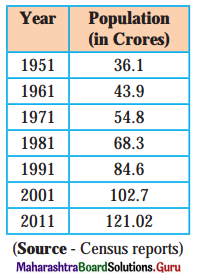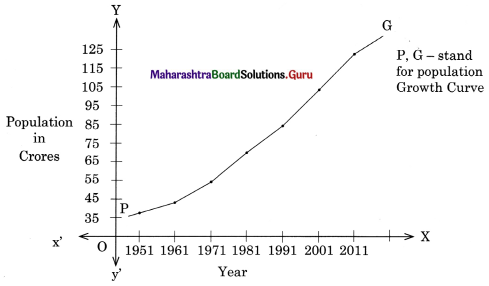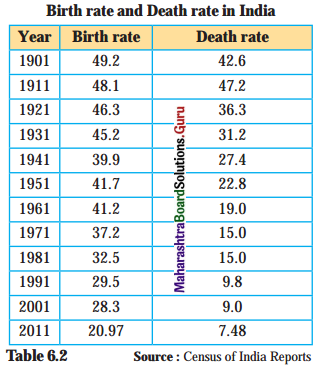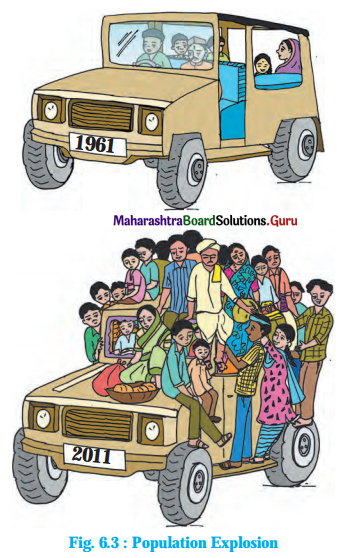Balbharti Maharashtra State Board Class 11 Economics Solutions Chapter 6 Population in India Textbook Exercise Questions and Answers.
Std 11 Economics Chapter 6 Question Answer Population in India Maharashtra Board
Class 11 Economics Chapter 6 Population in India Question Answer Maharashtra Board
Economics Class 11 Chapter 6 Question Answer Maharashtra Board
1. Choose the correct option:
Question 1.
Stages of the theory of demographic transition.
(a) High birth rate and high death rate
(b) High birth rate and low death rate
(c) Low birth rate and low death rate
(d) Economic development
Options:
(1) a and b
(2) a and c
(3) a, b and c
(4) a, b, c, and d
Answer:
(3) a, b and c
Question 2.
Incorrect reasons for the population explosion in India
(a) Illiteracy
(b) Universalization of Marriage
(c) Joint family system
(d) Upliftment in lifestyle
Options:
(1) a and b
(2) c and d
(3) a, b and c
(4) d
Answer:
(4) d
![]()
Question 3.
Remedies undertook to check population explosion
(a) To provide employment
(b) To improve women’s quality of life
(c) National Population Policy
(d) Disaster management
Options:
(1) d
(2) a and c
(3) c and d
(4) a, b and c
Answer:
(4) a, b and c
Question 4.
Choose the correct pair:
| Group ‘A’ | Group ‘B’ |
| 1. Year of Great Divide | (a) Stable population till 2045 |
| 2. A. J. Coale and E. M. Hoover | (b) 1921 |
| 3. Social Reforms | (c) Demographic Transition |
| 4. National Population Policy, 2000 | (d) Spread of education |
Options:
(1) 1-d, 2-c, 3-a, 4-b
(2) 1-b, 2-c, 3-d, 4-a
(3) 1-b, 2-a, 3-c, 4-d
(4) 1-c, 2-d, 3-a, 4-b
Answer:
(2) 1-b, 2-c, 3-d, 4-a
2. Give economic terms:
Question 1.
An increase in population is faster than economic growth and development.
Answer:
Population explosion
Question 2.
Difference between birth rate and death rate.
Answer:
Survival rate
Question 3.
The balance between natural resources and population growth.
Answer:
Optimum population
Question 4.
Programme introduced to reduce the birth rate in 1952.
Answer:
Family Planning Programme
![]()
3. Identify and explain the concepts from the given illustrations:
Question 1.
There were 40 births per 1000 in-country ‘A’ during a year.
Answer:
Birth Rate.
Birth rate means the number of births occurring per thousand of the living population during a year. It is also called the fertility rate.
Question 2.
In Mumbai city, public transport service is largely affected due to the growing population.
Answer:
High Density of Population.
The number of people living per square kilometer is known as the density of population.
In India, it is 382 people per square kilometer as per the 2011 Census which is very high.
Question 3.
In-country ‘B’ there are 15 deaths taking place per 1000 during a year.
Answer:
Death Rate.
Death rate means the number of deaths occurring per thousand of the living population during a year.
It is also called the mortality rate.
Question 4.
For a certain period of time, China had adopted the policy of ‘One child per family.
Answer:
Population policy.
China’s ‘One Child Policy’ was part of a birth planning program designed to control the size of its population.
4. Answer the following:
Question 1.
Explain the causes of the high birth rate.
Answer:
The causes of the high birth rate are as follows:
(i) Illiteracy:
A large proportion of the population in India is illiterate which means they are bound to be traditional, superstitious, ignorant, and irrational. So they have more children.
(ii) Universalization of Marriage:
In India, Marriage is considered a religious and social obligation. In spite of the spread of education, the attitude of people towards marriage remains unchanged.
(iii) Age of Marriage:
In India the average age for marriage is low. Hence, the childbearing period is long which is responsible for the high birth rate.
(iv) Preference for the male child:
Many parents don’t accept family planning till they have a son or desired number of sons. This is known as son meta-preference.
![]()
Question 2.
Explain the causes of a low death rate.
Answer:
The causes of the low death rate are as follows:
(i) Improvement in medical and health facilities:
Due to advanced medical and health facilities epidemics like the plague, cholera, malaria, smallpox, measles, TB, etc. have been controlled or eradicated. The invention of sulpha drugs, penicillin, antibiotics has helped to reduce the death rate among people. The number of hospitals, doctors, and nurses also have increased. This has reduced the death rate.
(ii) Decline in Maternal Mortality Rate:
There is a fall in the death rate among women after delivery because of the easy availability of doctors, nurses, medicines, and transport facilities.
(iii) Fall in infant mortality rate:
Due to an improvement in medical facilities and public health measures infant mortality has declined.
(iv) Increase in literacy:
The spread of education especially among women has helped them to take better care of their children. This has reduced the death rate.
Question 3.
Explain the role of human resources in economic development.
Answer:
Role of human resource in economic development:
- Economic growth is only a means and human development is the end i.e. the objective of economic growth and development is to improve human conditions and enlarge people’s choices.
- Human development increases political stability by reducing civil disturbances in society.
- Human development leads to an increase in human productivity i.e., investment in nutrition, health, and education results in higher productivity.
- Human development helps to control population growth, through increasing literacy specially in women.
- Human resource development contributes to improvement in life expectancy and literacy rate. This further improves the quality of life.
- Human resource development helps to bring about research and development. It motivates research in various educational institutions.
5. State with reasons whether you agree or disagree with the following statements:
Question 1.
India is experiencing Population Explosion.
Answer:
Yes, I do agree with the statement.
- India is going through a population explosion because in the post-independence period, the death rate has been falling rapidly and the birth rate is falling slowly and still remains very high. So, the survival rate is high.
- India is the second-largest country in the world.
- Between 1951 to 1971 population increased from 36.1 crores to 54.8 i.e. the population has increased more than 3 times in 2011 to 121.02 crores during these three decades. The annual population growth rate was more than 2%.
- That is why India is experiencing a population explosion.
![]()
Question 2.
The death rate is falling rapidly in India.
Answer:
Yes, I do agree with the statement.
- There has been improvement in medical and health facilities, the decline in maternal mortality rate, fall in infant mortality rate, increase in literacy rate, etc.
- Through public health measures, a better quality of food is available.
- The government has taken several steps to control natural calamities.
- This helps to mitigate all types of disasters thereby reducing the loss of lives.
- Hence, the death rate in India is falling rapidly.
Question 3.
Optimum population contributes to the economic development of a country.
Answer:
Yes, I do agree with the statement.
- Optimum population means there is a balance between population growth and the availability of natural resources.
- If the population grows faster then there will be a shortage of food supply, low employment opportunities, etc., and pressure will be there on the economic growth of the country.
- It will create social and economic imbalances in the economy.
- Whereas optimum population will lead to balance in social and economic growth resulting in faster growth of the country.
- Thus, an optimum population contributes to the economic development of a country.
Question 4.
Human resources play an important role in economic development.
Answer:
Yes, I do agree with the statement.
- The United Nations Development Programme (UNDP) has introduced the concept of ‘Human Development’ in 1990.
- Human resource development occurs through the provision of educational facilities, increase in literacy rate, especially among women tends to reduce birth rate and infant mortality rate. This contributes to population control.
- HRD contributes to improvement in life expectancy and literacy rate. This further improves the quality of life.
- Human development leads to an increase in human productivity, i.e. investment in nutrition, health, and education which results in higher productivity.
- Hence, human resources play an important role in economic development.
Question 5.
The birth rate is declining due to changes in the standard of living.
Answer:
Yes, I do agree with the statement.
- According to the 2011 Census, the birth rate in India is 20.9 which is low as compared to the 2001 Census.
- There are certain factors responsible for the declining birth rate.
- Awareness about health facilities.
- Joint Family System is now shaped into a nuclear family system.
- The cost of education is increased per child.
- Under the family planning programme, contraceptive pills are available.
- Due to all these reasons, the birth rate is declining in India.
![]()
6. Solve the following:
Question 1.
Find out Q3 from the given data.

Answer:
Arranging the data in ascending order:
36.1, 43.9, 54.8, 68.3, 84.6, 102.7, 121.02
Here, n = 7
Q3 = \(\frac{3(n+1)^{\text {th }}}{4}\) observation
Q3 = \(\frac{3(7+1)^{\mathrm{th}}}{4}\) observation
Q3 = 6th observation
Q3 = 102.7
Question 2.
Draw a population growth curve from the given data.

Answer:

11th Economics Digest Chapter 6 Population in India Intext Questions and Answers
Try this: (Textbook Page No. 38)
Based on the given table 6.2, explain how demographic transition theory is applicable to India.

Answer:
Both birth rate and death rate falling from 1901 to till 2011 due to that India is facing high growth of population explosion. Hence we can say India is experiencing the second stage of demographic transition.
Can you tell: (Textbook Page No. 38)
Observe Fig. 6.3 and draw inferences from it.

Answer:
Inferences drawn from the figure are as follows:
- In 1961 Birth rate and the Death rate was high as compared to the year 2011. Hence, there was less population in the year 1961.
- As the year passes by, the death rate is declining and the birth rate is inclining due to proper medication facilities, improvement in education facilities, etc.
- This all led to a population explosion in India. The year 2011 is a case of overpopulation.
Find out: (Textbook Page No. 39)
Legal age of marriage for males and females in different countries?
Answer:
| Countries | Male | Female |
| 1. India | 21 | 18 |
| 2. U.S.A | 18 | 16-17 |
| 3. Afghanistan | 18 | 16 |
| 4. Argentina | 18 | 18 |
| 5. Australia | 18 | 18 |
| 6. Bangladesh | 21 | 18 |
| 7. Bhutan | 18 | 18 |
| 8. China | 22 | 20 |
| 9. Cuba | 18 | 16 |
| 10. Egypt | 21 | 21 |
| 11. Germany | 18 | 18 |
| 12. Indonesia | 19 | 16 |
| 13. Japan | 20 | 20 |
| 14. Kuwait | 17 | 15 |
| 15. Singapore | 21 | 21 |
| 16. Thailand | 17 | 17 |
Note: Students may further refer to the internet for more information on the legal age of marriage.
![]()
Do you know: (Textbook Page No. 41)
Question 1.
What do you mean by Population Education?
Answer:
According to UNESCO – “Population Education is an educational programme which provides for a study of population situation of the family, the community, nation, and world with the purpose of developing in the students rational and responsible attitude and behaviour towards the situation”.
Question 2.
When does demographic dividend occur?
Answer:
Demographic dividend occurs when the proportion of working people to the total population is high.
11th Std Economics Questions And Answers:
- Basic Concepts in Economics Class 11 Economics Questions And Answers
- Money Class 11 Economics Questions And Answers
- Partition Values Class 11 Economics Questions And Answers
- The Economy of Maharashtra Class 11 Economics Questions And Answers
- Rural Development in India Class 11 Economics Questions And Answers
- Population in India Class 11 Economics Questions And Answers
- Unemployment in India Class 11 Economics Questions And Answers
- Poverty in India Class 11 Economics Questions And Answers
- Economic Policy of India Since 1991 Class 11 Economics Questions And Answers
- Economic Planning in India Class 11 Economics Questions And Answers